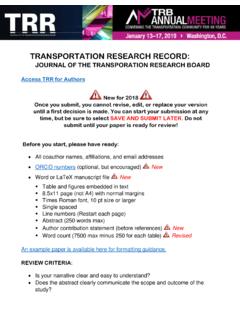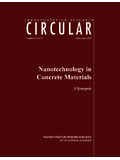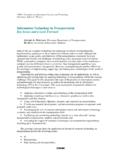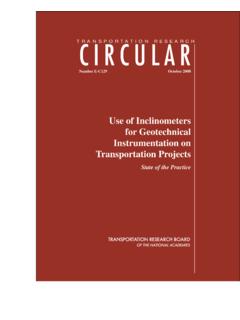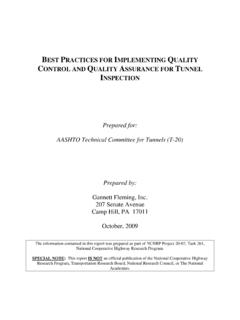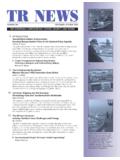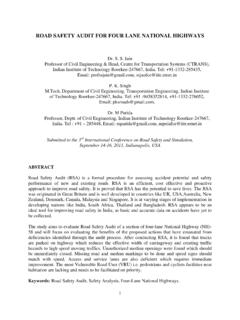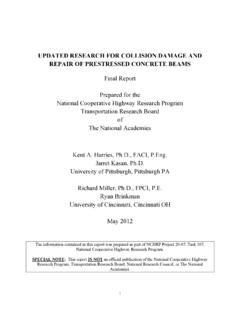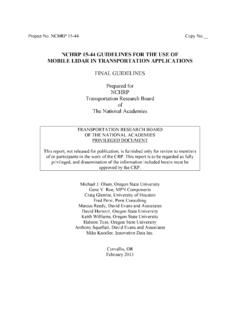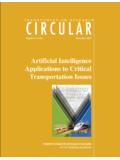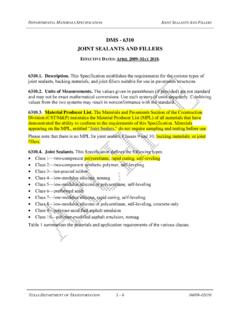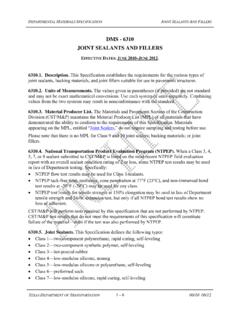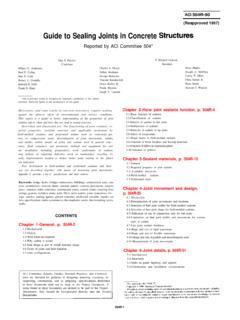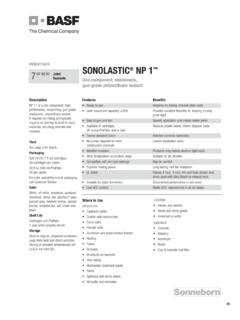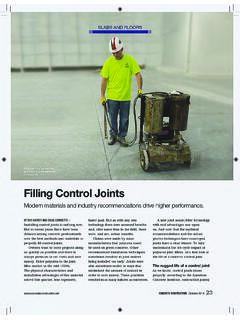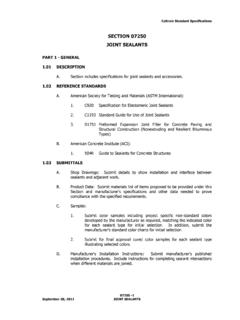Transcription of Joint- and Crack-Sealing Challenges
1 A3C13:Committee on Sealants and fillers for Joints and CracksChairman: Imad L. Al-QadiJoint- and Crack-Sealing ChallengesLARRY LYNCH, Army Engineer Waterways Experiment StationROBERT STEFFES, Iowa Department of TransportationJAMES CHEHOVITS, Crafco, VOIGT, American Concrete Pavement AssociationLYNN EVANS, ERES Consultants, L. AL-QADI, Virginia Polytechnic Institute and State UniversityThe pavement joint - and Crack-Sealing industry faces several Challenges as the newmillennium approaches. These Challenges cover a broad spectrum of issues, from materialsto construction practices. It has been demonstrated and documented and is generallyaccepted that sealing the cracks in flexible pavements is a sound preventive maintenanceprocedure for extending pavement life.
2 However, the fundamental question of whethersealing joints in rigid highway pavements is cost-effective was recently issues that face the joint - and Crack-Sealing industry can generally be divided intofour categories (within each of which are several subcategories, including a researchcomponent): Value added (return on investment from joint and crack sealing), Materials and specifications, Application procedures and equipment, and ADDED FROM PAVEMENT joint AND crack SEALINGP avement joint and crack sealants are designed to protect pavement by minimizing waterinfiltration and by preventing the accumulation of debris. crack sealing is an effectivetechnique for maintaining flexible pavements. Research has indicated that, in conjunctionwith maintenance techniques such as slurry seals and chip seals, crack sealing will extendthe life of a flexible benefits of sealing joints in rigid highway pavements have been well documented,but research conducted by the Wisconsin Department of Transportation (DOT) indicatessealing joints in rigid highway pavements is not beneficial.
3 Anecdotal information supportsthis finding. However, other information seems to show that joint sealant materials arevital to the protection of the pavement and that unsealed pavements deteriorate benefits of sealing joints in airfield pavements have not been thoroughly proven,but the risk of foreign object damage, for example, increases when joints spall. Aircraftengines can take up debris from spalled concrete and be destroyed. Thus, the use of jointsealing in airfield pavements will provide some insurance against potential aircraft engineTransportation in the New Millennium2damage. The relatively low cost of sealant may justify its use until its effectiveness isquantified as part of the life-cycle cost of pavement biggest challenge that faces the sealant industry as the next millennium approachesis quantifying the effectiveness of joint sealing in rigid pavements and its cost-to-benefitratio when considering the life-cycle cost of pavement service.
4 Another challenge is toidentify the right sealant for a specific job. The third challenge is training. If joint sealing isdetermined to be beneficial in a given situation, then contractors and users must be trainedin the appropriate kinds of materials that can be used for given applications, the correctinstallation geometry, and the procedures that are required to clean the joint or crack andinstall the AND SPECIFICATIONSD ifferent kinds of pavement (from both the material and use perspectives) require differentsealant materials. Now, and for the foreseeable future, hot-applied modified asphalt-basedsealants are the most effective and widely used sealant materials for use on flexiblepavements. The specifications used to identify the materials for crack sealing in flexiblepavements include ASTM D5078, ASTM D3405, Federal Specification SS-S-1401, andspecifications modified by state DOTs or other agencies.
5 Other kinds of materials such asemulsified, cutback, and chemically curing products will continue to be used in specificapplications where the costs or material characteristics of the products are kinds of sealant materials used for rigid pavement applications vary more widelythan those used for flexible pavements and depend on the pavement use. Historically, thehot-applied asphalt-based materials have been the most commonly used materials for theseapplications. However, silicone-based sealants (ASTM D5893) and preformedcompression-seal materials (ASTM D2628) have gained increased acceptance for use inrigid pavements and have become the preferred choice of a significant number of resistant to jet fuel (ASTM D3569, ASTM D3581, and Federal SpecificationSS-S-1614) and resistant to fuel and heat generated by aircraft exhaust (FederalSpecification SS-S-200) are commonly used for airfield pavements.
6 The use of silicone-based materials for airfield pavements that are exposed to intermittent or limited fuelspillage is increasing for civil and military applications. The military typicallyuses preformed compression seals, which are believed to provide a long-lasting seal in newpavements, during the new construction of airfield materials will continue to be developed for sealing cracks and joints in flexibleand rigid pavements in an effort to provide a more effective seal. As the new productsbecome available, it will be important to verify their performance in specific real challenge is to identify material properties and develop testing procedures thatcan be used to assess sealant performance in the field. The specifications currently used toidentify sealants for a given project have limited correlation to field performance.
7 Industryand the DOTs are increasingly interested in developing performance-based specifications provide two advantages. First, the performance of newlydeveloped materials could be more rapidly assessed against the known performance ofexisting sealants. Second, the most appropriate sealant could be objectively selected for aspecific set of conditions. For example, sealants that have better cold-temperatureSealants and fillers for Joints and Cracks 3properties could be selected for pavements in colder climates, and those with better hot-temperature properties could be selected for pavements in warmer investigations of laboratory characterization tests that could be used forperformance-based specifications have focused on procedures and concepts developedduring the Strategic Highway Research Program (SHRP) for performance grading ofasphalt cements and different kinds of adhesion (to substrate) tests.
8 A performance-basedspecification will need to include both material characterization procedures and material specifications alone will not improve the performance of crack and jointsealants in the field. Application procedures and equipment play a vital role in the fieldperformance of also may be required for project specifications. Warranties for joint sealantperformance have been discussed for several years, but they are rarely used in recently, warranties of 5 to 10 years have been implemented for pavementconstruction projects, and they also should be considered for joint - and Joint- sealing industry also must address safety issues, such as handling, fumes,toxicity, and disposal of both unused materials and materials removed from a resealingproject.
9 Manufacturers provide material safety data sheets that include instructions on theproper handling of their materials. When these instructions are followed, the workersshould remain safe. However, perceived health concerns require concerns are related to the composition of sealant materials. As in otherindustries, many materials that were acceptable for use several years ago now areconsidered potentially harmful to humans and the environment. Several chemicals havebeen replaced with acceptable ingredients, but the industry must continue to developenvironmentally safe PROCEDURES AND EQUIPMENTJ oint- and Crack-Sealing performance for rigid and flexible pavements was addressed in theSHRP research. Handbooks (1,2) were prepared that include guidance on how and when toseal as well as equipment used for sealing projects.
10 Guidelines for selecting the mosteconomical sealing or maintenance procedure also were procedures cover many aspects of joint - and Crack-Sealing projects, forexample, cleaning the joint or crack , configuring the sealant , and determining the shapefactor (depth-to-width ratio) for the sealant . Current procedures used to seal the joints ofconcrete pavements include sawing followed by waterblasting or sandblasting, airblasting,and installation of the backer rod and of the most critical aspects for good field performance of a sealant is properlycleaned joints. However, the industry has not reached a clear consensus on how to measurejoint cleanliness, the proper methods required to achieve a clean joint , or the degree ofcleanliness required so a joint will adhere properly.
